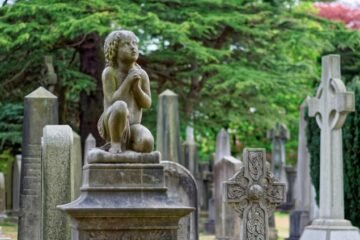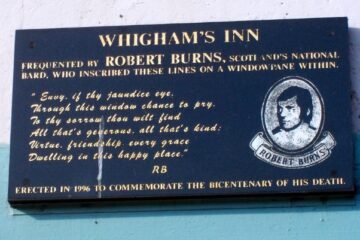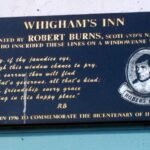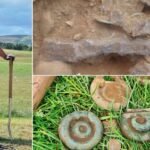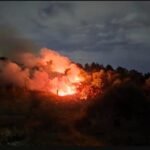In the far reaches of the Scottish Highlands, where the land opens into sky and the weather changes faster than you can lace a boot, stone-strewn trails curve quietly through heathered hills. They cut across empty glens, skirt lochs black as ink, and climb into wind-scoured passes that few cross today. These are coffin roads — paths of the dead — once trodden by mourners carrying the weight of the departed over many miles to reach sacred burial grounds.
Long before paved roads, hearses, or highways, communities in remote corners of Scotland had only their feet and faith to guide them. When someone died, the entire village became a funeral procession. Caskets were hoisted on shoulders, passed from bearer to bearer, winding through some of the UK’s most unforgiving terrain.
Today, those same trails — quiet, reverent, almost untouched — offer a very different kind of pilgrimage.
Rituals carved into the land
These weren’t just practical routes. They were part of a spiritual choreography that shaped how the Highlanders grieved.
Along the way, the casket was never allowed to touch the ground. Instead, it was set carefully on stone cairns built for rest stops — many of which still stand, lonely sentinels in otherwise empty moors. The procession followed winding paths, often crossing water, believed to confuse the spirit of the dead so it couldn’t find its way back home.
Even the direction of the corpse mattered: feet always pointed toward the final resting place, the journey becoming not just transport, but transformation.
In his book The Coffin Roads, theologian Ian Bradley describes these rites as part communal mourning, part supernatural insurance. The dead had to be ushered out properly — or risk staying.
“These were spaces of liminality,” Bradley writes. “Places where the boundary between the living and the dead was thinnest.”

A culture of keening, cairns, and whisky
Before the procession, the wake. It was never quiet. Keeners — women skilled in ritual lament — sang beside the body while whisky flowed freely. The entire village turned out. Death wasn’t hidden behind curtains or funeral homes. It was walked, wept over, and witnessed.
As the mourners set out, usually in groups of six or more, the coffin changed shoulders frequently. The terrain made sure of that. Uphill, across bog and stone, through windswept valleys where now only sheep roam — this was no symbolic journey. It was a hard one.
And yet, from these old griefs, something enduring remains: a connection between place and passage, story and soil.
“Not just any path”: Scotland’s coffin roads today
Tim Simons, a volunteer director at ScotWays, the charity dedicated to preserving Scotland’s public access routes, says coffin roads are often hidden in plain sight.
“Many of these paths were used only for funerals,” he says. “They didn’t serve any agricultural or daily travel purpose. That’s what makes them unique. But it also means a lot of them have disappeared.”
For those that remain, however, the rewards are extraordinary: haunting silence, untouched scenery, and a kind of gravity that’s hard to explain until you’re walking it yourself.
“You can do a whole route and not see a single soul,” Simons says. “It’s just you, the trail, and a lot of weather.”
Where to walk with the dead
Kilmartin Glen
The ceremonial route for beginners
Just a couple of hours from Glasgow, Kilmartin Glen offers one of the richest ritual landscapes in Britain. Over 350 ancient relics — cairns, barrows, standing stones — are scattered along a six-mile stretch, many older than the Pyramids.
Among them are the Kilmartin Stones, 79 engraved grave markers at the parish church. Though it’s a relatively short walk, just three miles over flat terrain, the sense of continuity with the dead is unmistakable. “There’s no evidence people lived in this glen,” Bradley notes. “Its sole purpose seems to have been commemorating the dead.”
A funeral route turned archaeological wonder — and still surprisingly quiet.
The Green Isle Walk
Loch-side elegy with views to eternity
Less than three miles, this out-and-back trail begins among Scots pine and Atlantic oak before leading to a pier on Loch Shiel — once a gathering point for caskets destined for the sacred St. Finan’s Isle.
Boats would carry the dead across the water to the “Green Isle,” an ancient Christian burial ground dating to the seventh century. Its chapel ruins and leaning crosses are still visible on the opposite shore, silhouetted against the loch’s dark surface.
Even today, the burial ground is in use.
Other notable coffin roads include:
| Route | Location | Approx. Length | Terrain | Notes |
|---|---|---|---|---|
| Glenelg to Loch Hourn | West Highlands | 8 miles | Rocky, steep | One of the most isolated coffin paths |
| Rhenigidale Track | Isle of Harris | 5 miles | Coastal | Now part of the Hebridean Way |
| Killin to Glen Lochay | Perthshire | 7 miles | Moorland | Used to access remote churchyards |
Each one offers more than just a walk. It’s a step into a cultural memory few modern nations preserve.
Echoes beneath the heather
There’s something about these paths that stays with you. Maybe it’s the silence — not emptiness, but presence. The sense that others have walked here in sorrow and ceremony. That the land remembers.
They’re not just trails. They’re stories in peat and stone.
Whether you walk them to grieve, to honour, or simply to listen, coffin roads still speak. You only have to follow.


